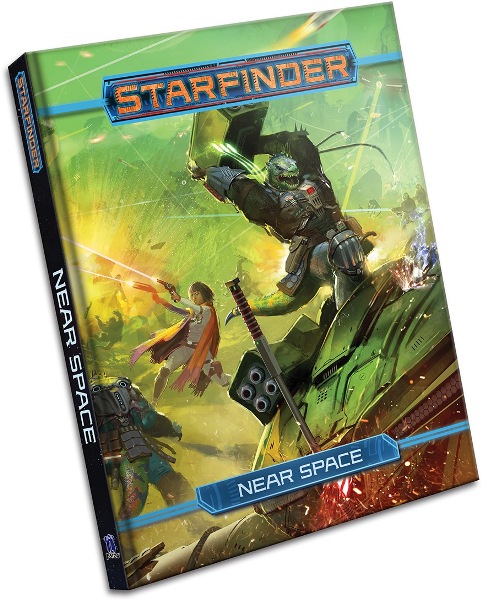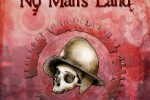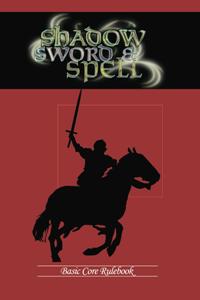
Product Name: Shadow, Sword & Spell: Basic
Publisher: Rogue Games
Author: Richard Iorio II, James Maliszewski
System: 12°
Setting: Shadow, Sword & Spell
Theme: Pulp Fantasy
Type: Core
Link: http://www.rogue-games.net/
Shadow, Sword & Spell is a blend of pulp action and fantasy mechanics, or simply put pulp fantasy. The action centers around the characters and the individual encounters they experience rather than experiencing a grand quest to save the world. The pulp aspects of the game blend bits of adventure, horror, and Earthly experiences while the fantasy aspects bring in ideals of magic and unearthly creatures. Rogue Games has learned and grown throughout their core releases with Shadow, Sword & Spell displaying a definite maturing of publication quality and core mechanic explanations.
The setting has many adventuring possibilities filled with great investigations, dynamic encounters, believable characters, and plenty of thieving and character growth. The 12° system developed by Rogue Games truly comes to life in these colorful but possibly excruciating battles which can find the adventuring party either coming out on top or limping off wounded and insane. With so many possibilities, it’s a great break from the typically found epic fantasy settings and systems.
A PRIMER
Shadow, Sword & Spell: Basic begins in typical fashion with an introduction to the ideals of Pulp Fantasy, the setting, and how the Player and GM experiences should feel. The book quickly moves into the basic mechanics of the 12° system and the basic overview of how dice rolling and tests are made. The 12° system is a roll-over system using 2d12 and a Target Number (TN) based of the characters skills and abilities and applicable modifiers. This means that the more improvement of a character’s skills or abilities results in a higher TN making the roll of 2d12 easier to achieve success. I’ve stated my feelings before of how I like the system, it’s inherent simplicity, and it’s ease of use. To add to this, I find the introduction of the 12° system within this book to be easy to understand and follow showing a positive progression of Rogue Games ability to explain their standard system.
CHARACTER CREATION
The book continues with Character Creation and is presented in the same easy-to-understand fashion as the introduction with a few tweaks pertaining to it’s use within a Pulp Fantasy setting. This version of the 12° system adds Sanity (as with Colonial Gothic) creating a feel that this definitely is not epic fantasy and the player characters (PC) should be cautious to remember that they’re not indestructible and the horrors of the world may be more powerful than is expected. I like this move and find it helps to bring out the pulp aspects of the system even though you may think your character is heroic.
All mechanics of the 12° system are properly explained including simple examples and a high quality presentation. To set this system apart from it’s brethren, background and culture options can create characters that widely range in stature. This mechanic adds to the pulp aspects and creates a new realistic feel to societal standings between the PCs. While creating possible contention, there are new ideals created for role-playing possibilities.
Moving on to the introduction of skills, Rogue Games has improved upon their explanations and examples resulting in a fantastic presentation. All of my previous confusions have been completely removed and all conflicting statements have been corrected. The chapter finishes out by fleshing out your character in typical fashion as before.
SKILLS AND HOOKS
Digging down into the details of skills and hooks, the book moves on to the full explanation of how skills work, skill tests, and the full listing of usable skills. While being a great selection of skills, the list avoids becoming bloated by presenting the players and GMs with too many skills that can often seem to perform the same thing. I also find the introduction of some of the new social skills to be conducive to great investigative and adventuring opportunities. Hooks and Action Points are then properly introduced and described giving players and GMs new ways to take the story into different directions. Hooks are available to give the players the ability to “change” the story or particular “scene” into something favorable for the PCs. Action Points give the players the ability to improve upon unfavorable dice rolls and give them a better chance to succeed. These mechanics are still as wonderful as the first time I read them and help to keep players more involved within the active storyline.
ECONOMY AND GEAR
Economy encompasses the different currencies found within the setting including a full description and their exchange rate. The majority of this chapter is dedicated to the different types of available gear including a good list of hand weapons, ranged weapons, and armor. The list of equipment is rather short and could potentially be expanded upon. However, lists of equipment could go on virtually forever if you wanted to include everything, so the current list is ample. I like the presentation of the weapons but what I really like is the table definitions found at the bottom of the table. This makes everything much easier to understand and follow. I can see this section being expanded upon extensively in subsequent products.
ACTION
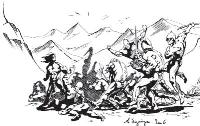
The reason we play, performing actions and experiencing their results. Shadow, Sword & Spell continues the use of allowing multiple actions to be performed regardless of their type by simply implying a multiple action penalty to your TN. I love the flexibility offered, giving the players and GM the ability to do virtually anything plausible within a given round. One thing new is the introduction of optional in-game effects including mechanics surrounding armor, damage, and sanity.
All typical actions and modifiers are introduced and properly described but feel more creative than regular epic fantasy. Much of these action mechanics create that pulp fiction or cinematic feel found throughout the setting. There are mechanics for poisons, drugs, mental disorders, and diseases. While some players may not like some of these mechanics in their game, they are presented in a way that allows for them to be omitted without consequential in-game effects. However, they are present and can build more dynamic encounters and adventures and give the PCs more problems to deal with.
THE MAGICAL ARTS
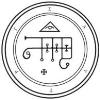
Magic within Shadow, Sword & Spell is real, but abuse could drive one insane. The magical arts are similar to a horror setting in that they are secretive, deadly, and shouldn’t be taken lightly. There are three types of magic found within: Common, Arcane, and Alchemy. Common are simple spells won’t drive one insane but don’t result in miraculous events. Arcane is more powerful and affects one’s sanity, but oddly enough there are no Arcane spells found in this book. I’m guessing they will become available in the follow-on core rulebook. Alchemy is wonderfully described and detailed being filled with all sorts of acids, poisons, antidotes, and elixirs. The mechanics are well-done although I would prefer to see more examples and more actual details rather than broad explanations. As already stated, I’m guessing these will also be expanded upon in the follow-on core rulebook.
GAME MASTERING AND SETTING
Game Mastering does a great job of introducing a GM to the concepts of Pulp Fantasy and how to write and run an adventure or campaign. While this section is meant to be for the GM, I find it important for players to read and understand so they know what to expect within the setting and what type of experience they will have. Considering the lack of true Pulp Fantasy settings available, this may be very new information for many players and GMs alike.
The Setting actually seems to be a snippet of the complete world setting Shadow, Sword & Spell is designed with but gives an extremely detailed introduction and description of the area found herein. This not only includes the geographical and physical traits but also includes government, society, religions, cults (including a couple Lovecraft references), guilds, and some of the activities found within. This is a great introduction to the setting and leaves a lot of ideas available for the GM to develop.
MUNDANE THREATS AND CREATURES
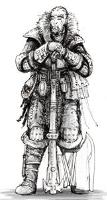
Shadow, Sword & Spell is stated as being a humanistic setting where you won’t find typical fantasy races. To expand upon this ideal, Rogue Games has presented a substantial listing of “mundane threats” which are humans of all walks of life. This list is quite large and ranges from sorcerers, to thieves and barbarians. A GM can easily create 3-dimensional NPCs from this list along with building great combat encounters for the adventuring party.
I was truly surprised by the creatures listing in that I wasn’t expecting quite the variety that is present. I was expecting the large listing of basic creatures, but the introduction of undead and horroresque creatures are a great way of expanding the setting. As with the Mundane Threats, the list is quite substantial and filled with opportunities for great combat encounters. I also truly appreciate the amount of illustrations present throughout both sections.
ADVENTURE
It’s difficult to review this adventure without giving away the plot, so I’ll keep this relatively brief. The adventure is a definite introductory adventure and is conducive to many different types of PCs. The storyline is fairly open in its description and creates many opportunities for GMs to enhance the overall experience. The combat is simple and fairly straight-forward but the open-ended plot points allow for further adventures to be written or even expanded to a prequel to an overall campaign. There are valuable maps and NPCs but it could benefit from illustrations of the important characters. However, it is meant as a launching point and does a good job of keeping to this idea.
APPENDIX
The Appendix contains a very valuable bibliography of fictional publications a GM can use to gather influence from for creating their own adventures and campaigns. The list is quite extensive and you can see the enthusiasm Rogue Games has for building a true Pulp Fantasy setting.
OVERALL
Overall I really like the deviation from standard epic fantasy into something more gritty and focusing on individual characters and the encounters they experience. The Basic book contains enough information for players and GMs to get involved in the setting while leaving plenty of room for those wishing to expand their gaming experience with the follow-on core rulebook.
RATINGS
Publication Quality: 10 out of 10
Rogue Games has demonstrated a definite maturing of their ability to provide quality products not only in description but also presentation. They continue to produce high-quality publications with an emphasis on usability and easy understanding. The improvements to mechanics explanations, examples, and illustrations should prove that these products will continue to get better and better with each subsequent release.
Mechanics: 9 out of 10
I find the 12° to be much simpler and easier to use than other fantasy-based systems and it truly shines within the framework of Shadow, Sword & Spell. The implementation of these mechanics should provide quality gaming experiences with quick and easy play. The incorporation of social mechanics provides more options for those who want more role-playing experiences while easily being removed without detrimental effects to those who wish for more combat style experiences.
Desire to Play: 9 out of 10
Rogue Games continues to produce games that deviate from many of the typically found settings currently published providing new options for many gaming groups. Instead of simply changing the same settings with new mechanics, Rogue Games provides a whole new gaming experience that many may find a desired change from their current games. This setting is very conducive to different styles of gaming improving it’s re-playability and offering new opportunities even within similar adventures or campaigns.
Overall: 9 out of 10
Shadow, Sword & Spell does a fantastic job of bringing to life a pulp fictional writing experience on your tabletop. The exclusion of the heroic feel means PCs can be as cruel or lawful as they like without deviating from the ideals of how the system is supposed to feel.

